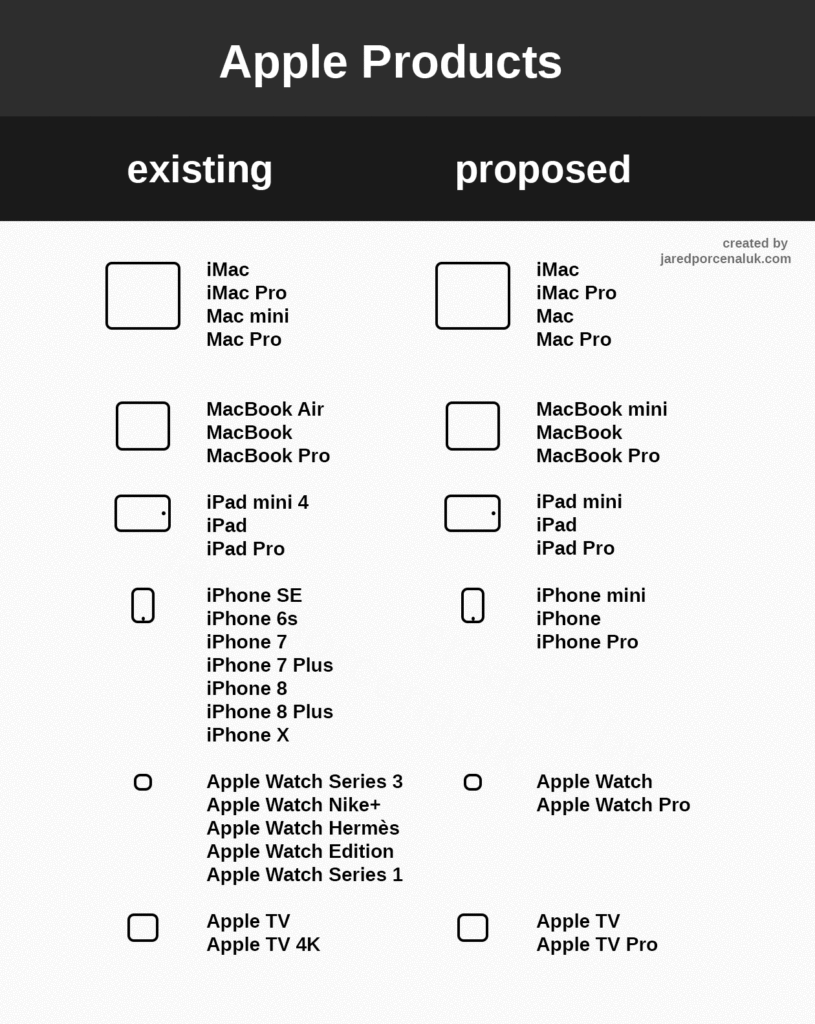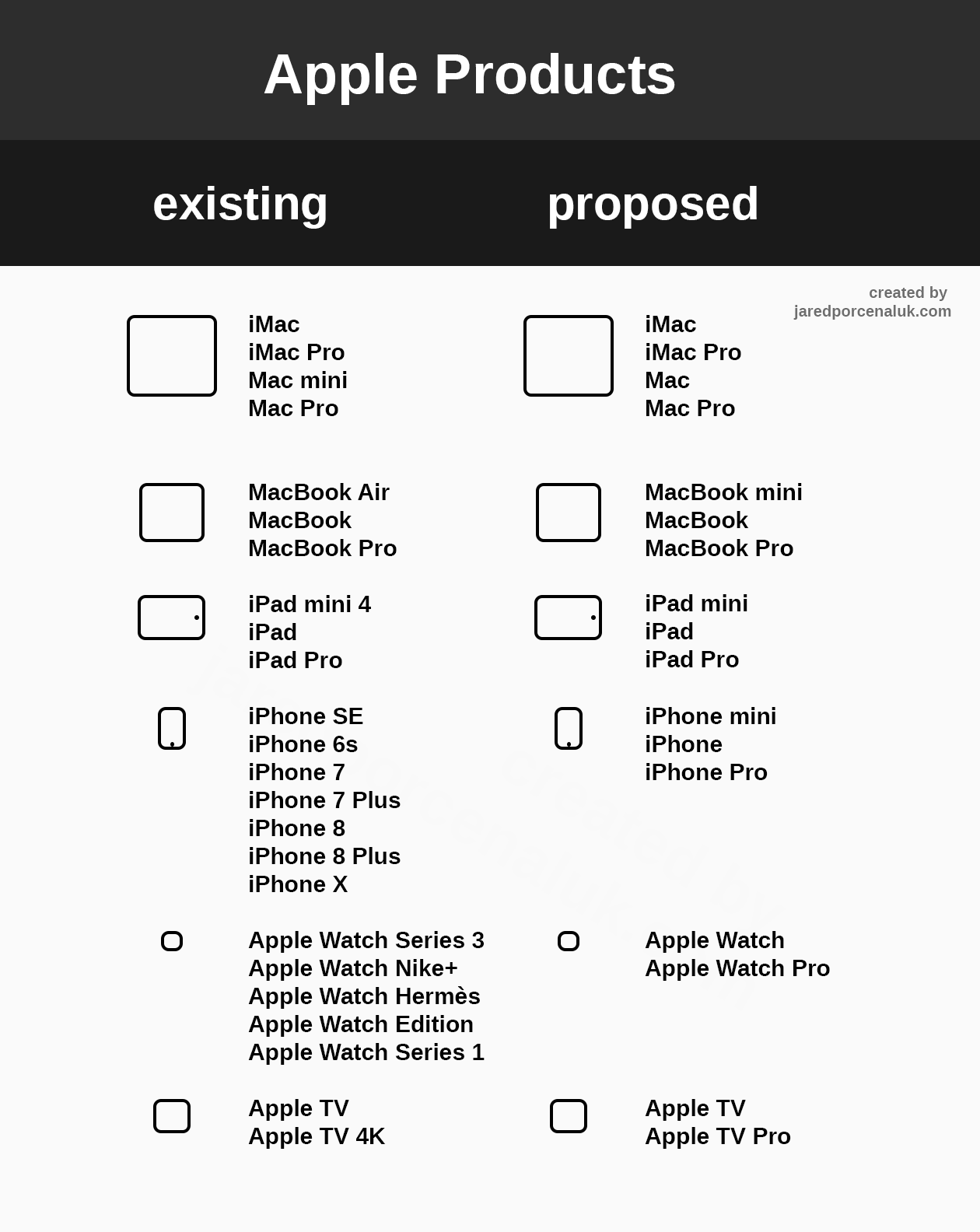
I have in my pocket my very first and only iPhone so far: a two-year-old iPhone 6s. Apple announces a new phone every year, and just this past September 12th, 2017, they announced the iPhone X. As in, iPhone 10.
No, that math doesn’t really work. They went from the 6s in 2015, to the 7 in 2016, to the 8 and X (as in 10) in 2017. They will be selling those models beside each other in the store, with a “regular” 8 and an 8 Plus variant to boot. In addition, they still have the old iPhone 7, iPhone SE, and as of right now, iPhone 6s for sale.
Confused? You are not alone. After the event, I was just flabbergasted at Apple’s lack of discipline. Apple’s designs have traditionally been simple. Austere. Cohesive. But their product line-up is anything but.
Steve Jobs was the reductionist, and Jonathan Ive is the dreamer. Without Steve being able to pull the reigns, however infamously tightly he may have held them, Ive and the rest of Apple is drifting into entropy.
There have been plenty of articles questioning if Apple is still innovative, but this is different. Even if they iterate on their products forever without completely disrupting the industry, they’ve let the weeds grow in their lineup. The iPad mini 4 sitting beside the iPad and iPad Pro? Why is there a now-arbitrary number there? It’s time to clean the slate. It’s time to prune the products.
My suggestion is to reduce the product lineup and stick to common naming conventions across the board.
No Numbers
There’s no reason for numbers. The Ford Mustang is iconic, and it’s not because we’re on Ford Mustang 6 right now. Yes, we’re in the 6th generation of Mustang, but did you know that? Did you care? You are probably more familiar with what matters to you. Maybe you think it is the epitome of adrenaline. It’s loud, it’s fast. Maybe what matters is that it is pure Americana on wheels. Whatever the case, you probably don’t really care what version number it wears.
Years
From now on, you have an iPhone. It’s a 2017. Or a 2016. Anything more specific than that is relegated to product numbers, which increment based on product id and date.
Most users won’t need to get more granular than the name. At the water cooler, they’ll mention the new iPhone and everyone will know what they’re talking about. It comes with 64 GB in the base model now. And now it has augmented reality.
mini
For the smaller versions of products, the cute lower-case “mini” works. Keep it, but make sure it’s consistently used. Goodbye Macbook Air, hello Macbook mini.
Product Name
Most consumers go for the middle option. The Mac. The MacBook. The iPhone. The middle-tier product in any lineup that Apple just goes by its name, unadulterated.
Pro
Apple will always appeal to those with unlimited budgets. For cost-no-object buyers, the highest-level version is the Pro. Mac Pro. MacBook Pro. iPhone Pro.
The i
The “i” means screen. The iMac, iPhone, and iPad all pull the screen to the forefront, with no keyboards or watchbands to get in the way.
That convention is fine, albeit not completely clear to the average consumer. Eventually they may want to consider moving away from the “i” convention, as in the Apple Phone and Apple Pad. However, the iPhone name is so entrenched in our culture that we’d be silly not to keep it. And we’ll let the iPad and iMac follow.
Mac
A Mac is a computer. It’s a legendary name. The Mac is the desktop, the iMac is the all-in-one with that beautiful screen, and the MacBook is the laptop.
Generic Names
Apple backed themselves in a corner with the Apple TV and Apple Watch. You can’t lop off the Apple part, or they become the lowercase version found in common vernacular. Calling it the iTV sounds like an awkward acronym, and the iWatch is just creepy. MacTV might work, but it’s not really a computer. MacWatch feels more McDonald’s than Apple, and again, not really a computer.
We’ll just keep the generic names with Apple in front of them for now. But we’re dropping the 4K in the newly announced Apple TV 4K. It’s great because it’s explicit, but Apple has never been about the underlying technology specs: they sell emotion. My mother doesn’t know what 4K means. She would know there’s a difference between an Apple TV and an Apple TV Pro, and she’d know the Pro has a sharper image and is more expensive.
Bonus: iOS and MacOS
Please just call it iOS and MacOS. Version them by number, 2017.1 and 2017.2. Why do we have iOS 11 and macOS High Sierra? No.
Conclusion
Apple, get your stuff together. We love your products but your current mix of blasé naming schemes leaves the average consumer at an arm’s length. Let’s keep things simple. You’ve got this.
